Donning the Robe
After a hard day of chasing deadlines,
the Captain’s concept of “spiritual healing”
typically means ensuring that the cap on his bottle of Southern
Comfort is nice and tight before placing it back in the cabinet.
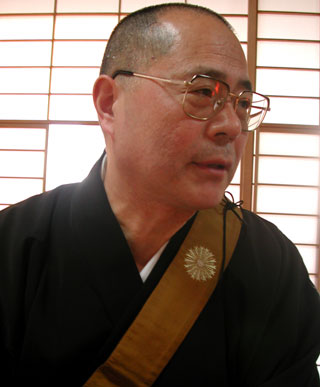 But
this week he’s entering a temple to chat about spirits
of a completely different kind with a Buddhist priest. The
incense is already burning, why don’t you step on inside?
But
this week he’s entering a temple to chat about spirits
of a completely different kind with a Buddhist priest. The
incense is already burning, why don’t you step on inside?
As incense emanates from a
few ceramic pots, Buddhist priest Gakushin Tsujimoto settles
back on the tatami mat of Renkeiji, the temple over which
he presides.
The temple is built into the residence he shares
with his wife, son and daughter. It is a modest home tucked
within a residential neighborhood above Yokohama
Bay. Nearby is the cemetery that Tsujimoto uses to provide
any of his deceased followers a proper Buddhist sendoff to
the afterlife.
With a buzz haircut, the stereotypical standard
in his line of work, and a gold sash over his gray robe, he
points at a series of posters hanging on the back wall above
a stack of purple pillows. There are a half-dozen in total,
each with black Chinese characters running down along the
white pages. One reads: “To change a person's mind you
have to take action.”
The always-smiling 62-year-old explains: "These
have been made so people can get hints inside my theories."
They work as sort of an icebreaker, an introduction
to Tsujimoto’s feelings and way of thinking. This is
necessary in his occupation; after all, many of his daily
duties deal with some rather intangible ideas.
"It is always hard to get people to understand
what I am trying to say,” he says. “I try to let
people understand happiness but they cannot understand easily.
Mentally and spiritually, I have to take care of people who
need help or guidance."
In summary, the 350 families under Tsujimoto’s
watch are expecting him to provide a balm for the soul. It
has been this way for priests in Japan for hundreds of years.
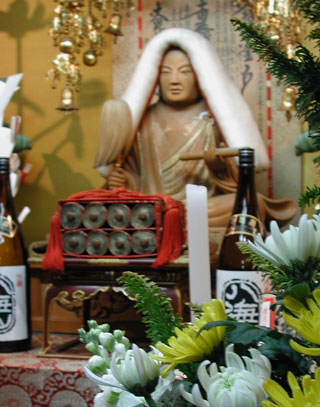 But
recent times have seen an added wrinkle in the average priest’s
robe. Accusations that the priesthood is increasingly becoming
a shroud for a lucrative business are common. For Tsujimoto,
he is old school; his priority rests with the well being of
his followers.
But
recent times have seen an added wrinkle in the average priest’s
robe. Accusations that the priesthood is increasingly becoming
a shroud for a lucrative business are common. For Tsujimoto,
he is old school; his priority rests with the well being of
his followers.
His daily routine always begins with a bang
- or more accurately, with the striking of a small cylindrical
gong - to signify the start of a prayer session. The gong
sits next to a large kneeling pillow slightly offset from
a butsudan, or small Buddhist memorial. A statue of
Nichiren, a 13th century priest who taught that all people
- regardless of race - could attain enlightenment, is perched
at the top of the tiered wooden structure. Sake
bottles, flowers, scrolls, and various other decorative
pieces occupy the lower shelves.
Once the prayer session of bowing, hand gestures,
and uttering of appropriate phrases is complete, Tsujimoto
then begins tending to his flock. He either receives them
at the temple or heads off to their residences.
Tsujimoto wants to get inside the minds of
his followers and help them with any troubling issues. Common
concerns are relationships, finance, and work.
Oftentimes his most difficult task is getting
them to turn off any preconceptions they may have of him and
simply listen to what he has to say. “New followers
can be rude; they think they are superior," he explains.
"So communication can be difficult. But after they start
to understand basic concepts on what it means to live, what
religion is, they start to learn how to listen to my thinking.
In the beginning is the hardest part."
The periods of ohigan, which literally
means "other shore" but implies transcendence to
enlightenment, in March and September and obon - the
time in July and August when the spirits of ancestors are
said to drift back to this world - are some of his busiest
times. During these periods, family members pay their respects
to their ancestors' graves, offering flowers or incense. "I
pray for the person's spirit in order to heal the spirit,"
Tsujimoto says of his role.
Perhaps Tsujimoto's biggest task is the administration
of funerals, which tend to be controversial undertakings in
Japan due to their extraordinary cost.
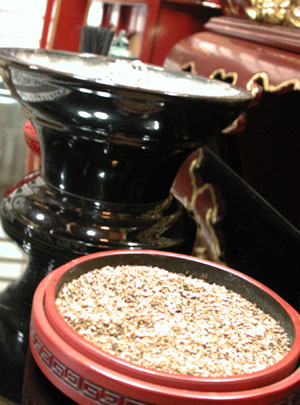 When
all is said and done a typical Japanese funeral goes for a
lofty 3 million yen - roughly four times that of the United
States. The industry is worth 1.5 trillion yen annually.
When
all is said and done a typical Japanese funeral goes for a
lofty 3 million yen - roughly four times that of the United
States. The industry is worth 1.5 trillion yen annually.
The point of contention is that the emphasis
has turned to money. The business is so competitive that the
practice of florists, funeral companies, and priests providing
kickbacks to hospital staff for information on fresh corpses.
"Regrettably I have to admit the business
aspect is more important for funerals and religious occasions,"
says Tsujimoto, who presides over around 20 funerals a year.
"In Japan, funeral companies take the lead and not the
priest so in this regard it is difficult to insist that religion
should come first. It is a sad thing for me."
The funeral is a three-step process for the
priest. On the first night of the deceased's passing, Tsujimoto
will find himself praying next to the person's sleeping pillow.
In days past the next day would entail a prayer session that
would run "all through the night" but recent times
have seen that prayer period revised down to one or two hours.
The last step is the cremation.
"After the burning of the body, the bones
are picked up (by members of the family)," says Tsujimoto
of the remains that will eventually find their way to the
family's cemetery plot. "Then I pray again. That is the
last prayer."
The element that likely raises the greatest
ire during the procedure is the preparation of kaimyo, a black
rectangular plaque with six to twelve characters. The characters
make up the person's posthumous Buddhist name.
Before the Edo Period (1603-1867), kaimyo was
reserved for priests when they were ordained. Since then they
are used to represent the achievements laymen after death.
The formula is simple: the higher the number of characters,
the greater the prestige...and the greater the charge. A recent
survey by the Tokyo Metropolitan Government found the average
kaimyo fee to be 400,000 yen.
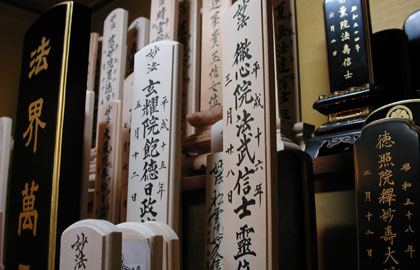 Public
outrage over such exorbitant fees four years ago caused the
Japan Buddhist Federation to issue the following statement:
"Kaimyo is not a commodity to be traded for money. Any
money or gift you give to your priest or temple is strictly
a donation you offer voluntarily."
Public
outrage over such exorbitant fees four years ago caused the
Japan Buddhist Federation to issue the following statement:
"Kaimyo is not a commodity to be traded for money. Any
money or gift you give to your priest or temple is strictly
a donation you offer voluntarily."
But the reality is usually quite different.
Relatives of a deceased person with the task of paying for
kaimyo usually experience something akin to looking over items
on a restaurant
menu, with each character having a price attached to it.
Tsujimoto, who guesses that his typical kaimyo charge is about
300,000 yen, is adamant that he chooses the characters and
merit is the determining factor.
"I receive an amount that the family can
afford," he says. "I do not give a specific price.
The main point is that the money is a donation. It is given
to express appreciation; it is a cleansing gesture, a symbol
of my work but also an appreciation for the dead person."
Renkeiji began from scratch four decades ago.
The area was not heavily developed but a few residents wanted
to establish a new temple. This was soon after Tsujimoto,
who entered the priesthood because he was not physically intimidating
as a child and just wanted a healthy life, had completed his
priest schooling.
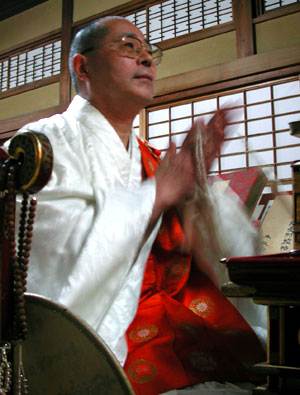 "I
was in a normal family, not a religious family," he remembers.
"In Buddhist schools, there are two types of people:
Those whose family is connected to a temple already and those
who are not."
"I
was in a normal family, not a religious family," he remembers.
"In Buddhist schools, there are two types of people:
Those whose family is connected to a temple already and those
who are not."
Today, things are still rather humble. The
temple, which from the outside could be easily mistaken for
a regular residence were it not for the small sign near the
entrance, relies on donations from the followers for survival.
Though Tsujimoto has managed to boost the number
of followers at his temple steadily over the years, he is
worried about the state of Buddhism in Japan as a whole. Modern
society might be leaving it behind.
“People's sense of values have changed,"
he says. "People are putting less emphasis on Buddhism.
Instead of religion, concrete matters are more important.
Something you can see has become more important than something
that is invisible.”
Tsujimoto thinks that individualism imported
from the West following World
War II has had an impact.
“Many people are moving from the suburbs
to the big cities," he says. "By moving to the city
they are losing their connection to their family, and the
family size gets smaller.”
Though by far the majority of priests inherit
their temple from their family, it is not uncommon to hear
of downsized office workers donning robes in recent years.
Tsujimoto says that such a transition is difficult given the
lack of experience the new priests possess.
As for the future of Renkeiji, Tsujimoto expects
his son to eventually take over his role. “But I am
not certain what he will do," Tsujimotos says. "He
has his own thinking."
Note: Kazuko Maruyama and Kaoru Shimizu contributed
to this report from the Yokohama Bureau.

